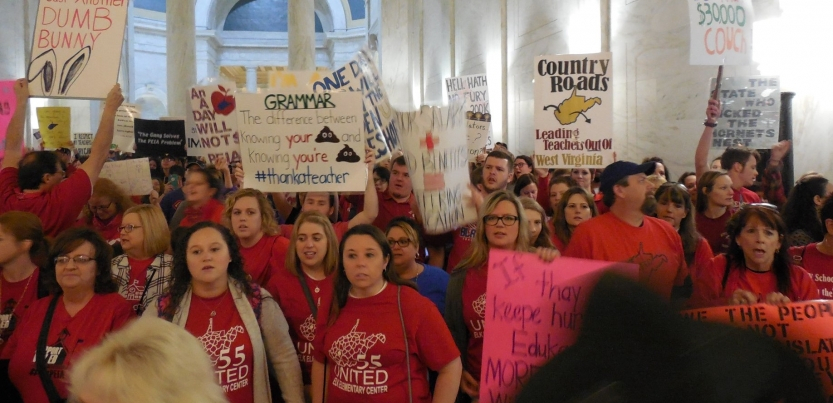West Virginia Teachers Run for Top Union Offices

West Virginia teachers thronged the Capitol in their nine-day strike in 2018. The bottom-up strike led to the founding of the WV United Caucus. Photo: West Virginia Education Association
By January 2020 I was feeling disenchanted with my union. As proud as I was of my colleagues and fellow members, I believed that we had a top-down organization.
I knew we could do better but I didn’t know how to begin.
Then I received a phone call from Jay O’Neal, asking me to consider joining the WV United Caucus. The Caucus believed that we could reorganize our unions to reflect democracy and to organize workers to fight.
DID NOT LEARN
After West Virginia's groundbreaking rank-and-file-led strike in 2018 (see sidebar), rather than learn from the members who had orchestrated the stoppage, union leadership continued as it had been.
THE 2018 STRIKE
In the fall of 2017 Jay O’Neal and Emily Comer began a secret Facebook group designed to create a safe forum for public employees. Thousands flocked to the page; soon the conversation turned to, “Why aren’t we striking?”
In February 2018 West Virginia education employees embarked on a nine-day strike that closed schools in every county, fighting for better salaries, affordable insurance, and public school funding. We were fighting for our students, too. Without protections that make education an appealing career, students will not have highly qualified professionals from whom to learn.
Observed Nicole McCormick, an administrator of the Facebook page and a WV United Caucus founder, “What made (the strike) work was talking to each other and not using the typical union structure.”
Nine days of collective action ensued—teachers, bus drivers, cooks, aides, secretaries, diagnosticians. The Capitol was flooded daily with red shirts demanding change for public education.
Even after union leaders reached a deal with lawmakers and called employees back to work, the deal was immediately rejected. Rather than return to our buildings, we continued our work stoppage till we could win a better compromise.
Reflects Nicole McCormick, now a candidate for West Virginia Education Association (WVEA) vice president, “What has surprised me most is how easily union leadership has fallen back into the same old pattern of miscommunication.”
We all knew that the strike had begun from the membership, not the union leadership. Conversations about how our unions should function and what we expect from them gained momentum. Later in 2018 the WV United Caucus, with members from all education unions in our right-to-work state, was born. That includes WVEA, American Federation of Teachers-West Virginia, and the West Virginia School Service Personnel Association.
The WV United Caucus has five core principles: Worker Empowerment, Solidarity Unionism, Progressive Taxation, Social Justice Unionism, and Grassroots Democracy. We believe these principles will enhance education for our students. From the 2018 strike, we learned that together we can move mountains.
Now we are running a slate of five to lead the WVEA (president, v.p., and three of the executive committee members). The vote will be held by mail after our virtual Delegate Assembly on May 23 and votes will be counted June 12.
Members will determine our issues. Front-runners include infrastructure (roads, water, electric, communications networks), strong internet access in our rural areas, mental health services for students, opioid addictions, and homes where students are being raised by someone other than their parents. We also have two major issues lingering from the 2018 strike: funneling public monies to private education in the forms of charter schools or vouchers and salaries and benefits to attract and retain the very best teachers we can.
We will set up committees that meet regularly. We will be transparent. We will work to create strong locals by removing roadblocks to participation, such as childcare and scheduling, and empower locals to take the initiative on matters that motivate them.
CAMPAIGNING
In our campaign we are learning that many members are experiencing the same frustrations that we are and want to see the union led by the rank-and-file members.
Not all members are receptive to our vision and some do not wish to deviate from the top-down model—we listen to them as well, and use all information we acquire to determine our next steps. If our goal is to fully represent our membership, we need input from all members, not just those who share our vision.
While we had planned in-person meetings, the coronavirus has changed that to online forums, which many members have logged onto. The campaign has shifted to making many phone calls and reaching out via social media, and it has gained even more energy. Each candidate is responsible for reaching specific counties, learning what their concerns are and sharing our vision. Caucus member Vera Miller explains, “The one thing that I would like to see change is more push from the bottom up. There's this common belief among members that the leadership will initiate any programs or initiatives. Instead, it should be the leadership following through with what the members initiate.”
Caucus members are studying the Labor Notes book Democracy Is Power to learn how to give our members the strength they need to be most effective at their jobs.
Should our campaign prove unsuccessful, we have started these conversations about how our members want to organize our union. The beginning is that very first conversation. In the words of Caucus member Rachel Reardon, “To me, the greatest benefit of belonging to a union is the feeling of solidarity with the other members. It is comforting and supportive to know that you are surrounded by like-minded individuals who feel the same as you do.”
Leslie Clayberger Haynes teaches reading in Jackson County and is running for the Executive Committee of the West Virginia Education Association.





